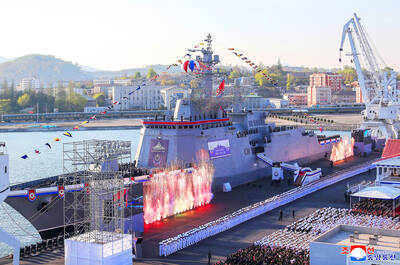At age 36, Hello Kitty may be running out of product lives.
That is the fear of executives at Sanrio Corp, the Japanese company that created the cute, cartoonish white cat in 1974 and groomed her into a global marketing phenomenon worth US$5 billion a year.
In Japan and around the world, Hello Kitty has been licensed over the years for products that include dolls, clothes, lunch boxes, stationery, kitchenware, a Macy’s parade balloon and even an Airbus owned by Taiwanese airline EVA Airways. But amid signs that Hello Kitty’s pop-culture appeal is waning, especially at home, where sales have shrunk for a decade, the company has struggled to find its next-generation version of adorable.
Sanrio’s recent flops include Spottie Dottie, a pink-frocked Dalmatian, and Pandapple, a baby panda. Even the moderately successful My Melody (a rabbit) and TuxedoSam (penguin) show no signs of achieving global Kitty-ness.
“We badly need something else,” said Yuko Yamaguchi, who has been Sanrio’s top Hello Kitty designer for most of its 36 years.
“Characters take a long time to develop and introduce to different markets, but Kitty has been so popular it’s overshadowed all our other efforts,” Yamaguchi said
One of Sanrio’s latest efforts is Jewelpet, a group of 33 sparkly eyed animals each with its own look. Diamond the black kitten is ladylike and decks out in pink bows. Sapphire is cool and prefers to wear blue. Sanrio’s thinking is that with so many to choose from, one has to stick.
A Sanrio savior would arrive not a moment too soon.
In a closely watched ranking of Japan’s most popular characters, compiled each year using sales data by the Tokyo-based research firm Character Databank, Hello Kitty lost her long-held spot as Japan’s top-grossing character in 2002 and has never recovered.
In the latest survey, released this month, Kitty ranked a distant third, behind the leader, Anpanman, a character that is based on a Japanese jam-filled pastry and is produced by Nippon Television. The second spot is still held by the venerable game and animation brand Pokemon, owned by Nintendo.
Sanrio is also being usurped by smaller, nimbler rivals. The formerly little-known stationery maker San-X has scored two huge hits in Japan with its panda character, Tarepanda, and its bear, Rilakkuma — which has charged up the Character Databank charts, ranking fifth in the latest survey.
Sanrio’s sales, which come from products as well as licensing, have reflected Kitty’s fading fortunes, shrinking for 10 consecutive years since 1999. The company’s overall sales in Japan fell 3.3 percent in the 12 months ending in March, Sanrio announced on Friday, as both licensing and sales of goods slumped. Hello Kitty fatigue is hitting Japan first, and hard, the company indicated.
However, a one-time 28 percent jump in overseas sales — which Sanrio attributed to an accounting change, as well as several big contracts overseas tied to Hello Kitty’s 35th birthday celebrations — helped the company swing back to a net profit of ¥4.37 billion (US$47.2 million), in contrast to a loss of ¥1.50 billion the previous year.
Sanrio now relies on overseas sales for 30 percent of its revenue, the company’s executive director, Susumu Emori, said on Friday. But Emori was cautious about Sanrio’s future overseas prospects.
“The last quarter was extraordinary, and we expect both sales and profit to fall this year,” he said.
Analysts say part of the problem is that Sanrio has oversold Hello Kitty, which appears on products as various as T-shirts, toilet paper and toasters. Sanrio was recently forced to write off the ¥500 million in debt held by Harmony Land, one of its two character theme parks in Japan, after a falloff in visitors, although the park remains open.
“Sanrio was initially very careful in making sure the Hello Kitty phenomenon didn’t get out of hand,” said Naohiro Shichijo, an associate professor in creative industries at the Waseda Institute for Advanced Studies in Tokyo.
“That’s the unspoken rule of the character business: You can’t let a character get too wildly popular all at once,” he said. “You want to go for longevity.”
Hello Kitty, introduced on a vinyl coin purse in 1974, became an instant phenomenon in Japan, and sales at Sanrio grew sevenfold in the cat’s first three years, but even then Sanrio’s founder and president, Shintaro Tsuji, expressed nervousness that consumers would burn out on the brand. Sanrio’s sales tapered off in the late 1970s, and then again in the mid-1990s when Japan entered a long economic slump.
Around 2000, however, Kitty surprised Sanrio by rebounding in a big way, with Hollywood stars wearing the cat on T-shirts and carrying Hello Kitty bags.
“But when you have a boom, you have a bust,” Shichijo said. “People get sick of it. Now Sanrio’s in trouble.”
Sanrio has tried to keep Hello Kitty up to the times: Sensing a move away from Japan’s love affair with the cute, or kawaii, aesthetic it has pushed an edgier look for the cat in the last three years, using as much black as pink.
Still, a sense of crisis is evident at the Tokyo offices of Sanrio, where 30 designers, led by Yamaguchi, are charged with developing new characters. At periodic product meetings, each designer presents as many as 20 characters for consideration by Yamaguchi. Of those, perhaps a dozen are chosen for trial sales at a pilot Sanrio store in Tokyo.
These days, designers are also urged to make sure their characters work across multiple media — a lesson Sanrio learned the hard way with Hello Kitty. Because Kitty had no mouth, it was difficult for the cat to break into television animation, depriving Sanrio of a lucrative source of revenue.
Sanrio’s designers are also told to aim their new characters at children in elementary school or younger — even if much of the marketing, especially in Japan, will be aimed at older consumers. When younger children embrace a character, many tend to remain fans even later in life, said Miyuki Okumura, the lead designer behind the Jewelpet series.

Archeologists in Peru on Thursday said they found the 5,000-year-old remains of a noblewoman at the sacred city of Caral, revealing the important role played by women in the oldest center of civilization in the Americas. “What has been discovered corresponds to a woman who apparently had elevated status, an elite woman,” archeologist David Palomino said. The mummy was found in Aspero, a sacred site within the city of Caral that was a garbage dump for more than 30 years until becoming an archeological site in the 1990s. Palomino said the carefully preserved remains, dating to 3,000BC, contained skin, part of the

TRUMP EFFECT: The win capped one of the most dramatic turnarounds in Canadian political history after the Conservatives had led the Liberals by more than 20 points Canadian Prime Minister Mark Carney yesterday pledged to win US President Donald Trump’s trade war after winning Canada’s election and leading his Liberal Party to another term in power. Following a campaign dominated by Trump’s tariffs and annexation threats, Carney promised to chart “a new path forward” in a world “fundamentally changed” by a US that is newly hostile to free trade. “We are over the shock of the American betrayal, but we should never forget the lessons,” said Carney, who led the central banks of Canada and the UK before entering politics earlier this year. “We will win this trade war and

‘BODIES EVERYWHERE’: The incident occurred at a Filipino festival celebrating an anti-colonial leader, with the driver described as a ‘lone suspect’ known to police Canadian police arrested a man on Saturday after a car plowed into a street party in the western Canadian city of Vancouver, killing a number of people. Authorities said the incident happened shortly after 8pm in Vancouver’s Sunset on Fraser neighborhood as members of the Filipino community gathered to celebrate Lapu Lapu Day. The festival, which commemorates a Filipino anti-colonial leader from the 16th century, falls this year on the weekend before Canada’s election. A 30-year-old local man was arrested at the scene, Vancouver police wrote on X. The driver was a “lone suspect” known to police, a police spokesperson told journalists at the

North Korean leader Kim Jong-un has unveiled a new naval destroyer, claiming it as a significant advancement toward his goal of expanding the operational range and preemptive strike capabilities of his nuclear-armed military, state media said yesterday. North Korea’s state-run Korean Central News Agency (KCNA) said Kim attended the launching ceremony for the 5,000-tonne warship on Friday at the western port of Nampo. Kim framed the arms buildup as a response to perceived threats from the US and its allies in Asia, who have been expanding joint military exercises amid rising tensions over the North’s nuclear program. He added that the acquisition